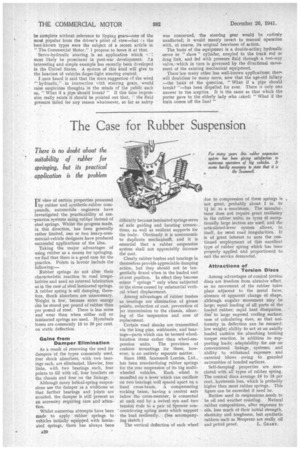The Case for Rubber Suspension
Page 22

If you've noticed an error in this article please click here to report it so we can fix it.
I N view of certain properties possessed by rubber and synthetic-rubber compounds, automobile engineers have investigated the, practicability of sus-pension systems using rublacr instead of steel springs. Whilst the progress made, in this direction, has been generally rather limited, one or two heavy-corntnercial-vehicle designers have produced successful applications of the idea. Taking the major advantages of using rubber as a mean e for 'springing, we find that there is a good case for the practice. Points in favour include the following:— Rubber springs do not alter their characteristic reaction to road irregularities and need no internal lubrication as in the case of steel laminated springs. A rubber spring is self damping, therefore, thock absorbers are unnecessary. Weight is low, because more energy Can be stored per pound of rubber than per pound of steel. There is less noise and wear than when either coil or laminated springs are used. Hysteresis losses are commonly 15 to 20 per cent. on static deflection.
Gains from Damper Elimination As a result of removing the need for dampers of the types commonly used, four shock absorbers, with two bearings each, are eliminated, likewise, four links, with two bearings each, four points to fill with oil, four brackets on the chassis and four on the linkage.
Although many helical-spring suspensions use the damper as a wishbone so that further bearings and joints are avoided, the damper is still present as an accessory requiring care and attention.
Whilst numerous attempts have been made to apply rubber springs to vehicles initially equipped with laminated springs, there has always been 1,20 difficulty because laminated springs serve as axle guiding and locating conncc-. tions, as well as resilient supports for the body. Obviously it is uneconomic to duplicate mechanista and it is essential that a rubber suspension system shall not appreciably increase the cost.
Clearly rubber-bushes and bearings in themselves provide appreciable damping action, but they should not be tangentially flexed when in the loaded and at-rest position. In effect they become minor " springs " only when subjected to the stress caused by substantial vertical wheel displacement.
Among advantages of rubber bushes as bearings are elimination of grease points, reduction of cost, prevention of jar transmission to the chassis, silencing of the suspension and case of replacement.
Certain road shocks are transmitted via the king pins, wishbones, and bearings—parts which can be termed wheellocation items -rather than wheel-suspension units. The provision of cushion mountings for these, however, is an entirely separate matter. '
Since 1933, Scarnmell Lorries, Ltd., has been standardizing rubber springs for the rear suspension of its big multiwheeled vehicles. Each wheel is moun'ted on a lever which can oscillate on two bearings well spaced apart on a fixed cross-beam. A compensating rocking beam, having a central axis below the cross-member, is connected at each end by a swivel eye and two tension rods to a pair of Spencer con' centric-ring spring nests which support the load resiliently. (See accompanying sketch.) The vertical deflection of each wheel due to compression of these springs is not great, probably about 1 in. to in as a maximum. The manufacturer does not require great resiliency in the rubber units, as tyres of exceptionally large iection are used, and the articulated-lever system allows, in itself, for most road irregularities. It is of great interest to note the continued employment of this excellent type of rubber spring which has been properly applied and proportioned to suit the service demanded.
Attractions of Torsion Discs Among advantages of conical torsion discs are freedom from abrasive effect, as no movement of the rubber takes place adjacent to the metal faces; absence of apparent change of shape. although angular movement may be large; equal loading of all parts of the loaded rubber; rapid heat dissipation, due' to large exposed cooling surface; ease of calculating sizes, so that uniformity in deflection can be ensured; low weight; ability to act as an axially loaded cushion for absorbing braking torque reaction, in addition to supporting loads; adaptability for use on conventional linkage, systems; and ability to withstand exposure and external blows owing to guarded extremities of bonded surfaces.
Self-damping properties are associated with all types of rubber spring. The conical discs average 1.6 to IS per cent., hysteresis loss, which is probably higher than most rubber springs. This figure can be exceeded if need be.
Rubber used in suspensions .needs to be oil and weather resisting. Natural rubber compositions, after exposure to oils, lose much of their initial strength, elasticity and toughness, but synthetic rubbers such as Neoprene are really oil
and petrol proof. L. GEARY.




















































